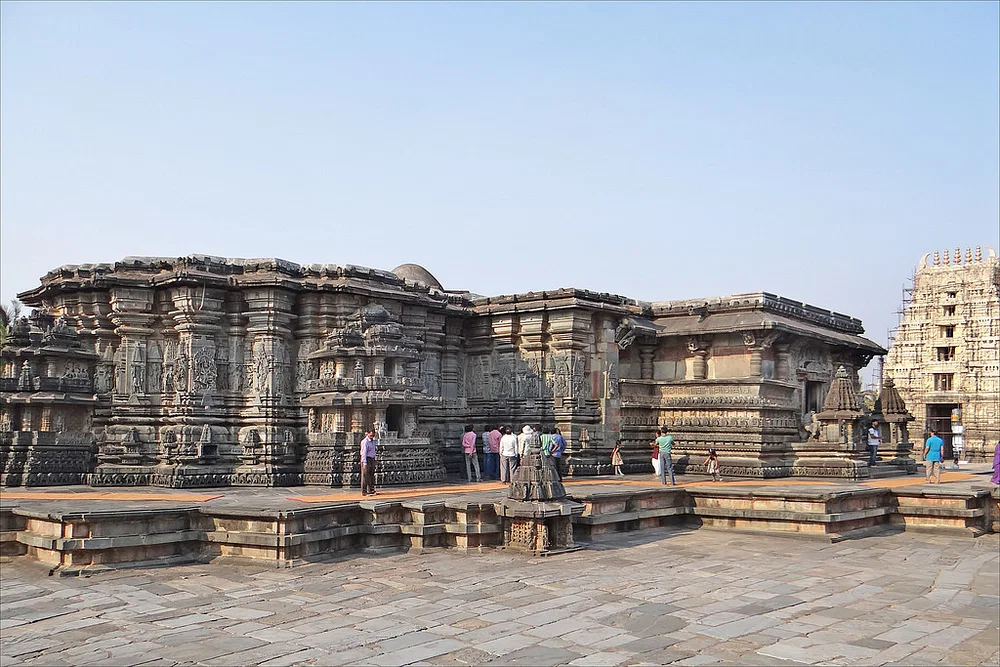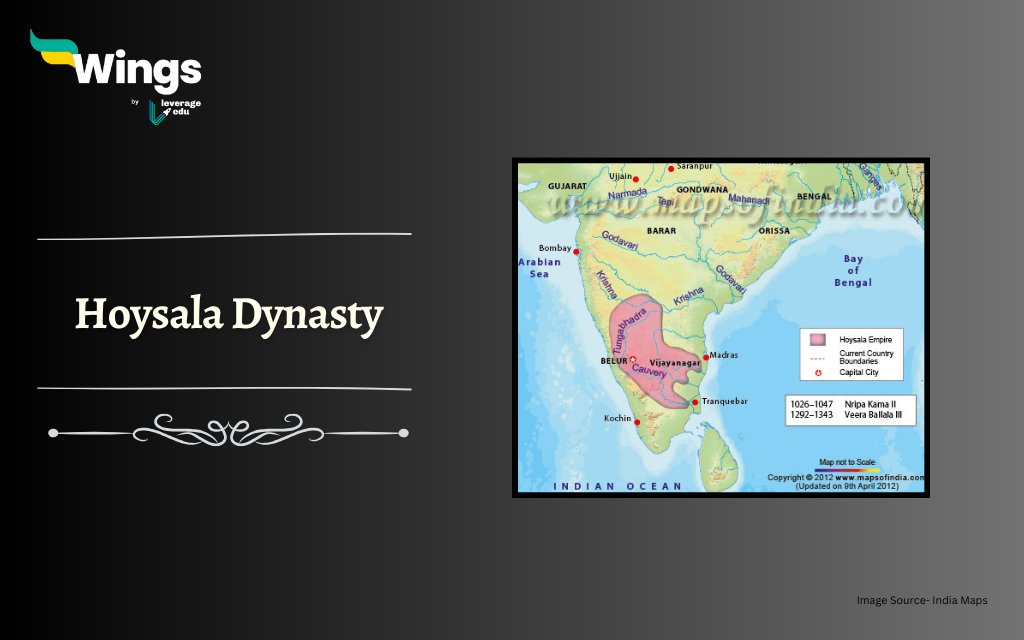The Hoysala Dynasty was one of the prominent and culturally rich dynasties in South India, presently Karnataka. Spanning over 400 years from c. 1050 -1355 CE, i.e. from the 10th to the 14th century, the Hoysalas surpassed their contemporaries with their patronage of temples and the construction of awe-inspiring architectural marvels. Let’s delve into the history of the Hoysalas, their kings, and the economy.
Contents
History of the Hoysala Dynasty
The history of the Hoysala Dynasty stretches back to the 10th century when they emerged as feudal lords in the Malnad region of Karnataka. Their rise to power can be attributed to the establishment of the dynasty by Sala, a brave military commander. Over time, the Hoysalas expanded their territory, gaining control over significant parts of present-day Karnataka.
According to their inscriptions, Sala performed a brave act wherein, he killed a ferocious tiger and earned the name “Hoysala”, which means the one who strikes. This tale is although symbolic but makes an important contribution to the tale of Hoysalas.
The history is not well documented, but they came to prominence during the conflict of the Cholas and the Chalukyas. They became independent from being a feudatory of Chaluky. Their capital was initially Belur, but later moved to Dvarasamudra presently Halebidu.
Also Read – Chera Dynasty: Kings, Administration, Religion & Conquests
List of Kings: The Glorious Lineage of the Hoysalas
Here is a list of the rulers of the Hoysala Dynasty and their contributions to the dynasty.
| Rulers | Year | Contribution |
| Sala | 963-966 CE | The founder of the Hoysala Dynasty, Sala laid the foundation for the dynasty’s prosperous future. Under his rule, the Hoysalas developed a strong military might. He was also known as Nripakama. |
| Vinayaditya | 968-1008 CE | He was the son of Sala and the Successor to the dynasty. He further added feathers to the hat of the dynasty by expanding his territory. |
| Ereyanga | 1008-1048 CE | Also known as Marasimha I. He was the successor of Vinayaditya. He contributed the expansion of the dynasty. |
| Veera Ballala I | 1048-1098 CE | He is considered as the ruler under whom famous Hoysala Temples were constructed which even include the famous Chennakesava Temple at Belur. |
| Vishnuvardhana | 1111-1152 CE | Known as the greatest ruler of the Hoysalas, Vishnuvardhana brought unparalleled fame and glory to the dynasty. He commissioned magnificent temples, including the renowned Hoysaleswara Temple at Halebidu |
| Narasimha I | 1152-1173 CE | He continued the legacy of the architectural marvels and is credited for the Kesava Temple at Somanathpura. |
| Ballala II | 1173-1220 CE | Ballala II continued the patronage of art and architecture, constructing several temples and serving as a vibrant hub for cultural activities. He came into conflict with the Kakatiya Dynasty and Yadavas of Devagiri. |
| Vira Narasimha II | 1220-1235 CE | He faced conflict with the rulers of the Chola dynasty and tried his best to put up a brave fight against his neighbouring powers. |
| Vira Someshwara | 1235-1263 CE | He was faced with many external challenges and became a weak link to sustain his legacy. |
| Narasimha III | 1263-1292 CE | This king faced several challenges, including invasions and internal conflicts, which marked the beginning of the dynasty’s decline. |
Administration of the Hoysala Dynasty
The King had the highest authority and the empire was divided into several provinces and each was administered by chiefs.
- The kingdom was divided according to geographical size and in descending orders as Nadu, Vishaya, Kampana and Desha.
- The administrative work at the local level was handled by various officials who were responsible for the collection of revenue and maintaining law and order. The king was the highest level for seeking justice.
- Some of the officials are –
- Gavundas – Revenue officer
- Pancha Pradhanas – Foreign affairs officers
- Sandhivigrahi – Chief Treasurer
- Hiranyabhandari or Mahabhandari – Top Level of Administrative affairs
- Dharmadhikari – Chief Justice of Hoysala Courts
- Nyayadhishas or Nyaymurtis – Local officials for local courts.
- Dandanayakas – Army Chiefs.
Economy of the Hoysala Kingdom
The Hoysalas, known for their administrative skills, skillfully managed their kingdom’s economy. This allowed them to flourish and accumulate wealth through trade, agriculture, and tribute from conquered territories. Some notable aspects of the Hoysala economy are:
Trade and Commerce
- The dynasty fostered trade relationships with foreign powers, including Arab nations and China.
- Economic prosperity was fueled by the trade of spices, precious stones, and sandalwood.
Agrarian Economy
- The Hoysalas developed an agrarian society, promoting irrigation methods and supporting the cultivation of rice, cotton, and sugarcane.
- They introduced effective land revenue systems, ensuring a stable income for the kingdom.
The primary source of income came from land revenue. They imposed various taxes like Sunka (for each land revenue settlement), Vira-sese (a War tax), Khana-Nibandha (special fodder charges) and Kudureya -sese (Horse contribution).
Also Read – Tughlaq Dynasty: Rulers of Delhi Sultanate
Decline: The Waning Glory of the Hoysala Dynasty
As with any dynasty, the Hoysalas experienced a gradual decline. Various factors contributed to this decline, including:
- Conflicts with Neighboring Kingdoms
- The Hoysalas faced constant territorial disputes with the Cholas and the Yadavas, weakening their hold on the kingdom.
- Internal feuds among royalty also added to the instability.
- Invasions by the Delhi Sultanate
- The Delhi Sultanate, under the leadership of Alauddin Khilji, invaded the Hoysala kingdom in the early 14th century.
- Despite fierce resistance, the Hoysalas could not withstand the military might of the Sultanate.
- Loss of Political Patronage
- The Hoysala Dynasty faced constant invasions from the Delhi Sultanate and the Vijayanagara Empire. These invasions weakened the dynasty and led to territorial losses.
- The decline of the dynasty was accompanied by a waning interest in temple construction and patronage of the arts.
- As a result, the distinctive Hoysala architectural style gradually faded away.

The Hoysala Dynasty’s awe-inspiring temple architecture left a mark of their forever existence in the Deccan region. Their 100 temples which are adorned with intricate carvings and sculptures, stand as a testament to their rich cultural heritage. Although the dynasty faced challenges and eventually declined, their contribution to South India’s history remains invaluable.
Relevant Blogs
| Maratha Empire (1674-1818) | Bahmani Kingdom |
| Kushan Dynasty | Pallava Dynasty |
| Khilji Dynasty (1290–1320) | Lodi Dynasty |
| Haryanka Dynasty | Gupta Empire |
| Rashrtrakutas Dynasty | Satavahana Dynasty |
That’s all about the Hoysala Dynasty! If you want to know more about topics like this, then visit our general knowledge page! Alternatively, you can also read our blog on general knowledge for competitive exams!
 One app for all your study abroad needs
One app for all your study abroad needs














